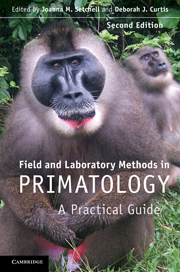Book contents
- Frontmatter
- Contents
- List of contributors
- Foreword by Robert D. Martin
- Introduction
- 1 An ethnoprimatological approach to interactions between human and non-human primates
- 2 Habituating primates: processes, techniques, variables and ethics
- 3 Habitat description and phenology
- 4 Geographical information systems and remote sensing
- 5 Monitoring local weather and climate
- 6 Survey and census methods: population distribution and density
- 7 Trapping primates
- 8 Handling, anaesthesia, health evaluation and biological sampling
- 9 Morphology, morphometrics and taxonomy
- 10 Marking and radio-tracking primates
- 11 Field experiments with non-human primates: a tutorial
- 12 Feeding ecology, frugivory and seed dispersal
- 13 Dietary analysis I: food physics
- 14 Dietary analysis II: food chemistry
- 15 Collecting arthropods and arthropod remains for primate studies
- 16 Recording primate vocalizations
- 17 Photography and video for field researchers
- 18 Chronobiological aspects of primate research
- 19 Thermoregulation and energetics
- 20 Field endocrinology: monitoring hormonal changes in free-ranging primates
- 21 Collection, storage and analysis of non-invasive genetic material in primate biology
- 22 Tips from the bush: an A–Z of suggestions for successful fieldwork
- Index
- References
12 - Feeding ecology, frugivory and seed dispersal
Published online by Cambridge University Press: 05 June 2012
- Frontmatter
- Contents
- List of contributors
- Foreword by Robert D. Martin
- Introduction
- 1 An ethnoprimatological approach to interactions between human and non-human primates
- 2 Habituating primates: processes, techniques, variables and ethics
- 3 Habitat description and phenology
- 4 Geographical information systems and remote sensing
- 5 Monitoring local weather and climate
- 6 Survey and census methods: population distribution and density
- 7 Trapping primates
- 8 Handling, anaesthesia, health evaluation and biological sampling
- 9 Morphology, morphometrics and taxonomy
- 10 Marking and radio-tracking primates
- 11 Field experiments with non-human primates: a tutorial
- 12 Feeding ecology, frugivory and seed dispersal
- 13 Dietary analysis I: food physics
- 14 Dietary analysis II: food chemistry
- 15 Collecting arthropods and arthropod remains for primate studies
- 16 Recording primate vocalizations
- 17 Photography and video for field researchers
- 18 Chronobiological aspects of primate research
- 19 Thermoregulation and energetics
- 20 Field endocrinology: monitoring hormonal changes in free-ranging primates
- 21 Collection, storage and analysis of non-invasive genetic material in primate biology
- 22 Tips from the bush: an A–Z of suggestions for successful fieldwork
- Index
- References
Summary
INTRODUCTION
Frugivores are among the most diverse and abundant of tropical vertebrates. Studying them is thus a central part of tropical biology. Because fruit availability fluctuates throughout the year, most frugivores have variable diets that may include leaves, fruits, flowers and seeds, as well as insects or other animal matter. Identifying food plants and parts eaten is a critical part of this research, but can be complicated when you are studying canopy-dwelling animals in regions with diverse flora. Frugivores are often described as important ecological interactors (mutualists) because of their role as seed dispersers (Howe & Miriti, 2004). Studying plant and animal strategies simultaneously is no simple task, but doing so provides new perspectives on botany, feeding ecology, digestive physiology, coevolution and plant–animal interdependence, which may provide valuable tools for conservation (Lambert & Chapman, 2005; Link & Di Fiore, 2006; Barrera et al., 2008; Nunez-Iturri et al., 2008). Particularly in the tropics, endozoochory remains one area in which the dedicated natural historian still has much to reveal to the world of science. Here, I describe some of the methods and equipment required for animal observation, plant sample identification, and the analysis of faecal contents and feeding remains. I also give some practical advice on studying ranging, seed dispersal, gut passage times, seed germination and seedling survivorship in the field.
- Type
- Chapter
- Information
- Field and Laboratory Methods in PrimatologyA Practical Guide, pp. 225 - 236Publisher: Cambridge University PressPrint publication year: 2011
References
- 1
- Cited by



